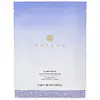What's inside
What's inside
 Key Ingredients
Key Ingredients

 Benefits
Benefits

 Concerns
Concerns

 Ingredients Side-by-side
Ingredients Side-by-side

Water
Skin ConditioningGlycerin
HumectantPropanediol
SolventMethyl Gluceth-20
HumectantAlcohol
AntimicrobialPPG-6-Decyltetradeceth-20
EmulsifyingEthylhexylglycerin
Skin ConditioningPolyglyceryl-10 Eicosanedioate/Tetradecanedioate
Skin ConditioningPolyglyceryl-10 Isostearate
Skin ConditioningChondrus Crispus Extract
Skin ConditioningParfum
MaskingSericin
Skin ConditioningXanthan Gum
EmulsifyingCamellia Sinensis Leaf Extract
AntimicrobialSodium Hyaluronate
HumectantPanax Ginseng Root Extract
EmollientAlgae Extract
EmollientRoyal Jelly Extract
Skin ConditioningThymus Serpyllum Extract
Skin ConditioningPhenoxyethanol
PreservativeWater, Glycerin, Propanediol, Methyl Gluceth-20, Alcohol, PPG-6-Decyltetradeceth-20, Ethylhexylglycerin, Polyglyceryl-10 Eicosanedioate/Tetradecanedioate, Polyglyceryl-10 Isostearate, Chondrus Crispus Extract, Parfum, Sericin, Xanthan Gum, Camellia Sinensis Leaf Extract, Sodium Hyaluronate, Panax Ginseng Root Extract, Algae Extract, Royal Jelly Extract, Thymus Serpyllum Extract, Phenoxyethanol
Water
Skin ConditioningGlycerin
HumectantDipropylene Glycol
HumectantBenzyl Glycol
SolventChondrus Crispus Powder
AbrasiveCeratonia Siliqua Gum
EmollientXanthan Gum
EmulsifyingCellulose Gum
Emulsion StabilisingPEG-60 Hydrogenated Castor Oil
EmulsifyingAllantoin
Skin ConditioningCaffeine
Skin ConditioningEthylhexylglycerin
Skin ConditioningCyamopsis Tetragonoloba Gum
Emulsion StabilisingAgar
MaskingSynthetic Fluorphlogopite
Raspberry Ketone
MaskingCalcium Lactate
AstringentTocopheryl Acetate
AntioxidantPotassium Chloride
Glucose
HumectantDisodium EDTA
Mica
Cosmetic ColorantCaprylic/Capric Triglyceride
MaskingTitanium/Titanium Dioxide
Cosmetic ColorantButylene Glycol
Humectant1,2-Hexanediol
Skin ConditioningUbiquinone
AntioxidantHydrogenated Lecithin
EmulsifyingHydrolyzed Collagen
EmollientSodium Hyaluronate
HumectantGlucosyl Hesperidin
HumectantTin Oxide
AbrasiveUndaria Pinnatifida Extract
Skin ConditioningSodium Phosphate
BufferingCorallina Officinalis Extract
Skin ConditioningCaprylyl Glycol
EmollientSodium Benzoate
MaskingNonapeptide-1
Skin ConditioningAcetyl Tetrapeptide-5
HumectantPotassium Sorbate
PreservativeDisodium Phosphate
BufferingCI 77891
Cosmetic ColorantCI 77007
Cosmetic ColorantWater, Glycerin, Dipropylene Glycol, Benzyl Glycol, Chondrus Crispus Powder, Ceratonia Siliqua Gum, Xanthan Gum, Cellulose Gum, PEG-60 Hydrogenated Castor Oil, Allantoin, Caffeine, Ethylhexylglycerin, Cyamopsis Tetragonoloba Gum, Agar, Synthetic Fluorphlogopite, Raspberry Ketone, Calcium Lactate, Tocopheryl Acetate, Potassium Chloride, Glucose, Disodium EDTA, Mica, Caprylic/Capric Triglyceride, Titanium/Titanium Dioxide, Butylene Glycol, 1,2-Hexanediol, Ubiquinone, Hydrogenated Lecithin, Hydrolyzed Collagen, Sodium Hyaluronate, Glucosyl Hesperidin, Tin Oxide, Undaria Pinnatifida Extract, Sodium Phosphate, Corallina Officinalis Extract, Caprylyl Glycol, Sodium Benzoate, Nonapeptide-1, Acetyl Tetrapeptide-5, Potassium Sorbate, Disodium Phosphate, CI 77891, CI 77007
Ingredients Explained
These ingredients are found in both products.
Ingredients higher up in an ingredient list are typically present in a larger amount.
Ethylhexylglycerin (we can't pronounce this either) is commonly used as a preservative and skin softener. It is derived from glyceryl.
You might see Ethylhexylglycerin often paired with other preservatives such as phenoxyethanol. Ethylhexylglycerin has been found to increase the effectiveness of these other preservatives.
Glycerin is already naturally found in your skin. It helps moisturize and protect your skin.
A study from 2016 found glycerin to be more effective as a humectant than AHAs and hyaluronic acid.
As a humectant, it helps the skin stay hydrated by pulling moisture to your skin. The low molecular weight of glycerin allows it to pull moisture into the deeper layers of your skin.
Hydrated skin improves your skin barrier; Your skin barrier helps protect against irritants and bacteria.
Glycerin has also been found to have antimicrobial and antiviral properties. Due to these properties, glycerin is often used in wound and burn treatments.
In cosmetics, glycerin is usually derived from plants such as soybean or palm. However, it can also be sourced from animals, such as tallow or animal fat.
This ingredient is organic, colorless, odorless, and non-toxic.
Glycerin is the name for this ingredient in American English. British English uses Glycerol/Glycerine.
Learn more about GlycerinSodium Hyaluronate is hyaluronic acid's salt form. It is commonly derived from the sodium salt of hyaluronic acid.
Like hyaluronic acid, it is great at holding water and acts as a humectant. This makes it a great skin hydrating ingredient.
Sodium Hyaluronate is naturally occurring in our bodies and is mostly found in eye fluid and joints.
These are some other common types of Hyaluronic Acid:
Learn more about Sodium HyaluronateWater. It's the most common cosmetic ingredient of all. You'll usually see it at the top of ingredient lists, meaning that it makes up the largest part of the product.
So why is it so popular? Water most often acts as a solvent - this means that it helps dissolve other ingredients into the formulation.
You'll also recognize water as that liquid we all need to stay alive. If you see this, drink a glass of water. Stay hydrated!
Learn more about WaterXanthan gum is used as a stabilizer and thickener within cosmetic products. It helps give products a sticky, thick feeling - preventing them from being too runny.
On the technical side of things, xanthan gum is a polysaccharide - a combination consisting of multiple sugar molecules bonded together.
Xanthan gum is a pretty common and great ingredient. It is a natural, non-toxic, non-irritating ingredient that is also commonly used in food products.
Learn more about Xanthan Gum